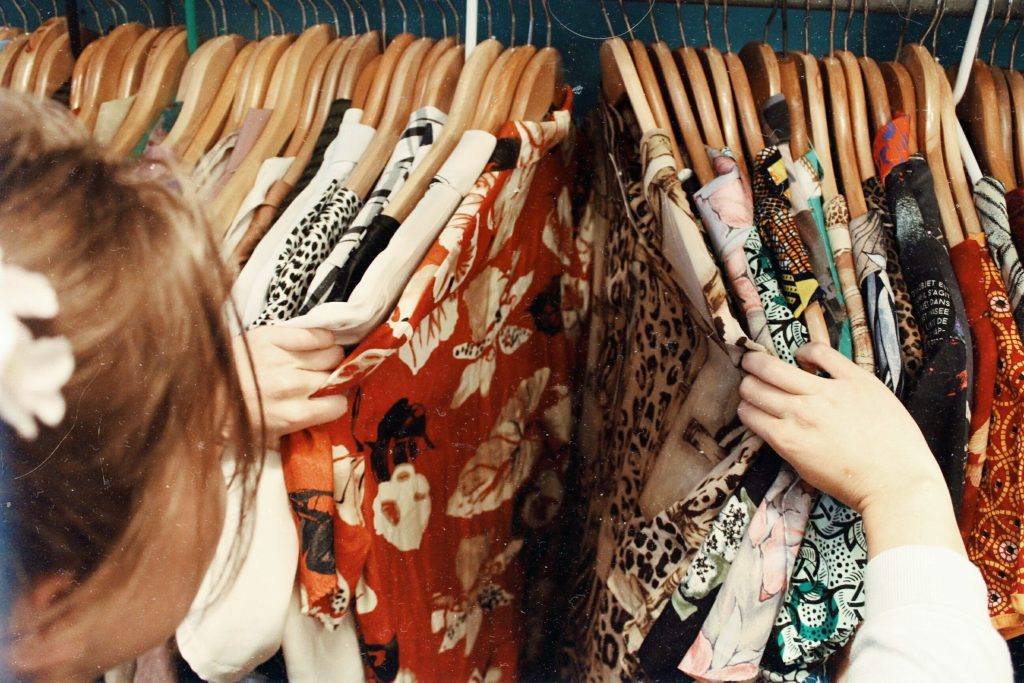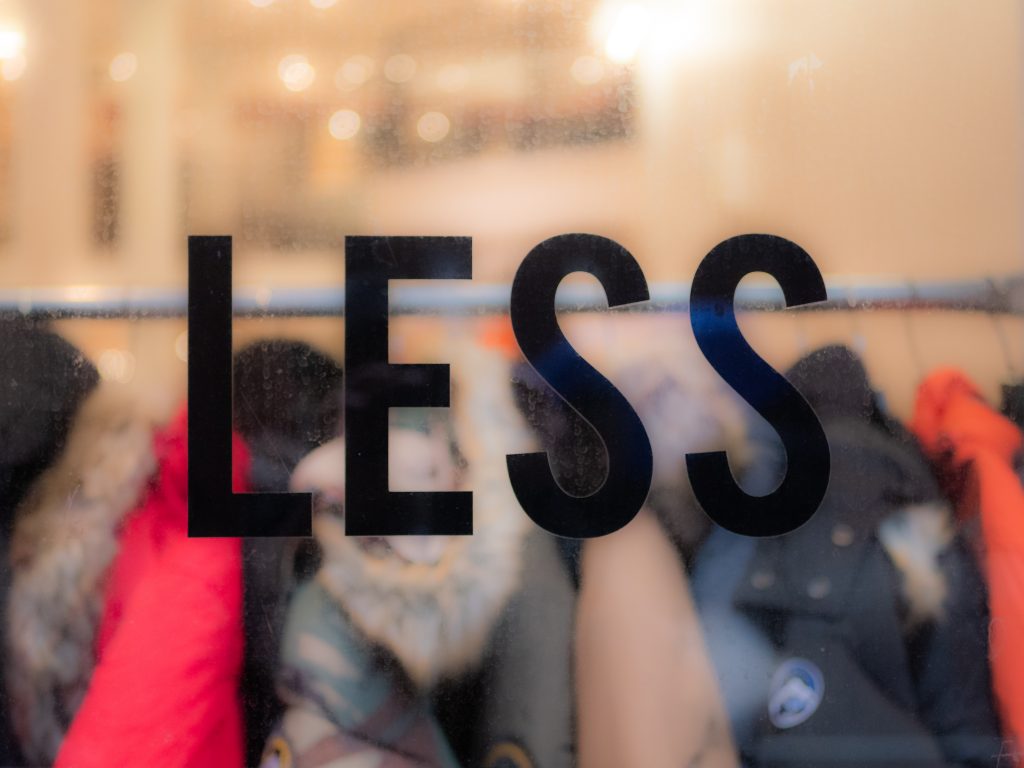The Fashion Iceberg
Edsa Marie Abella; Jan Lai; Jessica Tran; Kunlaporn Sribuddee; and Leshona Lennard

Introduction & Topic Overview
“The fashion wears out more apparel than the man” (Shakespeare, 1599). Fashion is defined by trends and changes. With the mass production, cheap labour, and overconsumption, the fashion industry is accountable for an estimated 8%-10% of global greenhouse gas emissions (Ro, 2020). Most fibres commonly used in the industry, such as polyester, are plastic fibres and non-biodegradable. Unfortunately, only 15% is recycled or donated, and the rest goes directly to the landfill or is incinerated. This waste can take up to 200 years to decompose (Cosgrove, 2019).
According to Quantis sustainability consultants, by 2030, the climate impact of the fashion industry is expected to increase by 49% (as cited Explains, 2021). Sustainable fashion has become an urgent issue for us, and for our generation. Sustainable fashion is not only about using sustainable materials, but also about fair pay, workplace safety, education, and climate change.
Local and Global Perspectives
The negative impact of fashion waste and fast fashion have many impacts on our planet and many countries. Fast, cheap, and widely available clothes have changed the way people buy and dispose of clothing. By selling clothes in this marketing strategy, fast fashion has led to high clothing consumption in many areas. Consequently, consumption patterns have created millions of tons of fashion waste in landfills and uncontrolled settings, especially in low and middle-income countries like Cambodia and Australia. The world’s biggest fashion market like China has to heavily rely on polyester, which is a cheap synthetic plastic fibre, derived from non-renewable fossil fuels at a considerable energy cost. The by-products from fossil extractions like polyester and cotton that depend on large amounts of water for cultivation are both extremely toxic to our environment.
Those workers who work or live near fabric manufacturing factories have to bear the excessive effect of environmental health risks, such as workers in Cambodia. They work in kilns factories where most of the garments that have to be burned contain polyester fibre, and this can affect employees as they are exposed to toxic substances from burning plastic like microplastics.
Currently, fashion waste is a global problem that has a serious impact on the world. So, many countries have created many methods, laws, campaigns, and innovations in order to reduce the impact of fast fashion on the environment. Many organisations encourage the fashion industry to move away from fossil-based fibres and scaling down production. They are creating a campaign to increase wages and minimum wages for garment workers in the clothes manufacturing industry to reduce the production rate. Moreover, international organisations like United Nations (UN) also agreed on creating Sustainable Development Goal (SDG) 12, which calls for sustainable consumption and production as part of national plans, to build sustainable business practices, change consumer behaviour, and eliminate fast fashion. Most importantly, consumers can also make changes and reduce fashion waste by reducing their consumption rate in new clothes and considered more on second hand clothes, having a conscious choice to buy natural/organic or renewable products, and considering fashion circularity before making a purchase.

Critical Analysis
The article “Could Living Wages Help Solve Fashion’s Climate Crisis? New Research Says Yes,” was written by Elizabeth L. Cline. Forbes published the article on January 17, 2022. The article’s main argument is that paying decent living wages to garment workers would create fundamental change in the fashion industry and reduce the impact of fashion waste on the environment. In the article, Cline (2022) introduced the “Rebound Effect”, a term coined by Roland Geyer. Geyer created this term to describe the phenomena whereby increases in green technology/materials will drive up consumption, resulting in no environmental improvements. Simply put, greener clothing means more consumption.
Cline presents two new perspectives to counteract this phenomenon: the “Reverse Rebound Effect” and “Green Labour Theory ”. The “Reverse Rebound Effect” is the idea that every dollar spent on people’s time and skills has no innate environmental impact. For example, when a person buys a t-shirt that a worker was paid fair wages to produce, there is no environmental impact because the consumer paid for the worker’s time. The “Green Labour Theory” works through the “Reverse Rebound Effect” and consists of two strategies. First, a simple $10 a day increase in garment worker wages would also contribute to an additional $84 billion annually in the economy. Secondly, when clothing production requires more time and skills, labour can be used “to increase the aesthetics, quality, or repairability of garments” (Geyer, as cited in Cline, 2022, para. 16). This creates a shift in the industry from fast fashion to quality clothing.
The author’s purpose for writing this article is to inform and persuade readers. She informs readers that labour, as opposed to green technology, has no environmental impact and draws emissions down. She also states that no mainstream climate action plans regarding fashion mentions working conditions (Cline, 2022). Cline persuades readers that better pay for garment workers is fundamental to addressing the fashion industry’s waste production and can lead to more skilled workers. Lastly, she emphasizes that better wages can help achieve two SDGs: labour rights and environmental issues (Cline, 2022).
Geyer states, “Every dollar spent on labour is an environmentally impact-free dollar. It’s a zero-carbon dollar. It’s a zero-biodiversity-impact dollar.” (Cited in Cline, 2022, para. 6). This quote emphasizes that increasing wages for garment workers can directly impact poverty and climate change. The quote encourages readers to understand labour as a factor influencing fashion waste—a factor that would otherwise be overlooked. It challenges us to think more critically about alternative solutions.

Local and Global Solutions
Tackling fashion waste has been a daunting task more than ever. From traditional state-based approaches to provocative discourses spearheaded by new-generation organization leaders, the issue has been brought to a series of local and national roundtables amongst the biggest players in the fashion industry, the local governments, and all other stakeholders.
In Australia, the government aims to combat national textile waste under its National Product Stewardship Scheme, developed by the Australian Fashion Council (Australian Government, n.d.). In May 2021, the Australian government held its first National Clothing Textile Waste roundtable in collaboration with key stakeholders drawing on a myriad of expertise across the country to come up with a holistic action plan (Taylor, 2021). China, as the world’s top textile exporter, recently set an ambitious goal to heighten its recycling rate to 30% by 2030, in its more comprehensive action plan in line with its green plan to become carbon neutral by 2060 (Lee, 2022). In May 2021, the Canadian government through its Innovative Solutions Canada program, awarded grants to four local companies to create solutions to reduce plastic waste, which mainly consists of textile waste (Vitello, 2021).
In collaboration with the national government, diverse organizations work hand in hand to address a pressing issue such as fashion waste. Among these, are the likes of Fashion Takes Action and Remake Our World, which both aim at rallying sustainability measures in the entire fashion system through education, raising awareness, research, and collaboration. In particular, Fashion Takes Action is a Canadian-based organization that carries out programs such as Wear Conference, workshops pertaining to Employee Education, introducing Sustainable Fashion Toolkit, and conducting youth education programs such as the My Clothes My World program (Fashion Takes Action, 2022). Remake Our World is a global advocacy organization based in the United States of America that was founded by both millennials and Gen Z activists who push for a rather provoking and holistic way to combat the said issue by fighting for fair worker’s wages and climate justice to eradicate, if not alleviate, the biggest trend in the fashion industry which no one wants to be seen in…fashion waste (Remake Our World, 2022).

Conclusion
Overall, fashion waste is a problem of many layers and as such, it requires as many angles to approach it as the number of layers that there are to it. On the surface, fashion waste may appear to seem like a simple problem of the reduction and elimination of waste created from the production of clothes, but it is ultimately a combination of issues related to fair pay, workplace safety, education, and climate change. Similarly, establishing a permanent solution to fashion waste is not a simple matter of making the materials used for production more sustainable, but ultimately a matter of combining together different solutions that are effective in their own way—changes in policies or laws, campaigns, or innovations—while also complementing each other and addressing the solution from different dimensions. As fashion waste is a problem that exists on as much of a global scale as it does, it is critical for us to always remember that the resolution of a challenge like this requires a communal and collaborative approach—solutions that are created through combining many minds together.
References
Australian Government. (n.d.). Clothing textiles. DCCEEW. https://www.dcceew.gov.au/environment/protection/waste/product-stewardship/textile-waste-roundtable
Bick, R., Halsey, E., & Ekenga, C. C. (2018, December 27). The global environmental injustice of fast fashion. BioMed Central. from https://ehjournal.biomedcentral.com/counter/pdf/10.1186/s12940-018-0433-7.pdf?pdf=button%20sticky
Bloomberg News (2020, October 18). China’s next problem is recycling 26 million tons of discarded clothes. https://www.bloomberg.com/news/features/2020-10-18/china-s-big-fashion-problem-is-recycling-26-million-tons-of-used-clothes?leadSource=uverify%20wall
Charpail, M. (2017). What’s wrong with the fashion industry? Sustain Your Style. https://www.sustainyourstyle.org/en/whats-wrong-with-the-fashion-industry
Cline, E. (2022, January 17). Could living wages help solve fashion’s climate crisis? New research says yes. Forbes. https://www.forbes.com/sites/elizabethlcline/2022/01/17/could-living-wages-help-solve-fashions-climate-crisis-new-research-says-yes/?sh=264e6faf6b27&fbclid=IwAR12InCfp7LRDTetIOpoDNflXwb-ecFO4RFu1jwybkDfoBU0dsa1X1n-_7I
Cosgrove, E. (2019, July 23). Why are fashion supply chains so wasteful? Supply Chain Dive. https://www.supplychaindive.com/news/fashion-supply-chains-wasteful/559254/
Explains, K. (2021, March 13). Can the fashion industry be sustainable? Medium. https://medium.com/age-of-awareness/can-the-fashion-industry-be-sustainable-86216d2341b0
Fashion Takes Action (2022). About. https://fashiontakesaction.com/
Hawley, L. (2022, April 11). The growing problem rocking the fashion industry: ‘A hidden issue’. https://style.nine.com.au/latest/clothing-textile-waste-in-australia-fashion/09c6920a-9fad-4e25-a57d-41252c7011d8
Kasztelan, M., & Quashie-Idun, S. (2022, August 8). Revealed: Garment waste from Nike, Clarks and other leading brands burned to fuel toxic kilns in Cambodia. Unearthed. https://unearthed.greenpeace.org/2022/08/08/garment-waste-nike-clarks-cambodia-bonded-workers-toxic/
Kelly, C. (2022, July 20). Australians buy almost 15kg of clothes every year and most of it ends up in landfill, report finds. The Guardian. https://www.theguardian.com/australia-news/2022/jul/20/australians-buy-almost-15kg-of-clothes-every-year-and-most-of-it-ends-up-in-landfill-report-finds#:~:text=4%20months%20old-,Australians%20buy%20almost%2015kg%20of%20clothes%20every%20year%20and%20most,up%20in%20landfill%2C%20report%20finds&text=Australians%20buy%2014.8kg%20of,per%20capita%20in%20the%20world
Law, V. (2022, March 21). Current perspective on Sustainable Fashion: Can we make it the norm? Not Just a Label. from https://www.notjustalabel.com/editorial/current-perspective-sustainable-fashion-can-we-make-it-norm
Lee, C. (2022, May 28). Inside China’s plan to clean up its textile industry. FairPlanet. https://www.fairplanet.org/story/inside-chinas-plan-to-clean-up-its-textile-industry/
Liam, T. (2021, July 28). Tackling Australia’s textile waste. Planet Ark. https://www.planetark.org/newsroom/news/tackling-australias-textile-waste
Rashmila, M. (2022, June 12). Fast fashion and its environmental impact. Earth.Org. https://earth.org/fast-fashions-detrimental-effect-on-the-environment/
Remake Our World. (2022). About. https://remake.world/
Ro, C. (2020, March 10). Can fashion ever be sustainable? BBC. https://www.bbc.com/future/article/20200310-sustainable-fashion-how-to-buy-clothes-good-for-the-climate
Shakespeare, W. (1955). Much ado about nothing: Act 3, scene 3. Folger Shakespeare Library. https://shakespeare.folger.edu/shakespeares-works/much-ado-about-nothing/act-3-scene-3/?search=The%20fashion%20wears%20out%20more%20apparel%20than%20the%20man/#line-3.3.139
Vitello, C. (2021, May 5). Made-in-Canada solutions to plastics waste receive support. Environment Journal. https://environmentjournal.ca/made-in-canada-solutions-to-plastics-waste/
Wohlgemuth, V. (2022, August 11). Cambodia workers pay the price of fast fashion’s supply chain waste problem. Greenpeace. https://www.greenpeace.org/international/story/55134/cambodia-workers-pay-the-price-of-fast-fashions-supply-chain-waste-problem/
Xue, Y. (2022, November 19). China’s fashion industry struts its stuff for sustainability: Can small players match Uniqlo, Nike in going green? South China Morning Post. https://www.scmp.com/business/article/3200101/chinas-fashion-industry-struts-its-stuff-sustainability-can-small-players-match-uniqlo-nike-going

